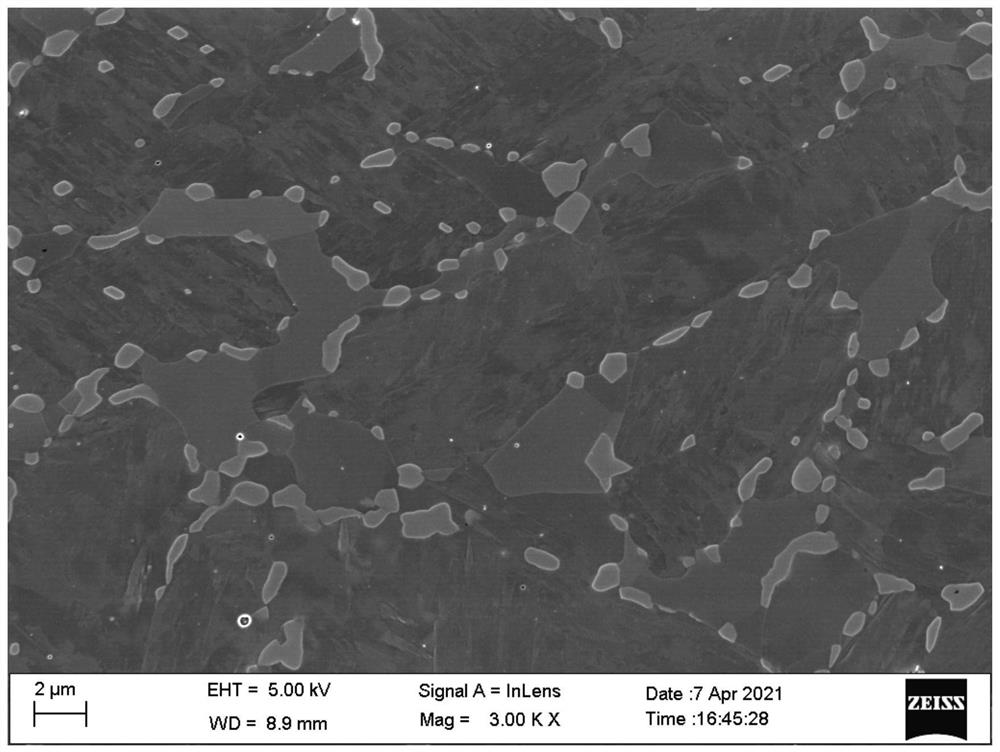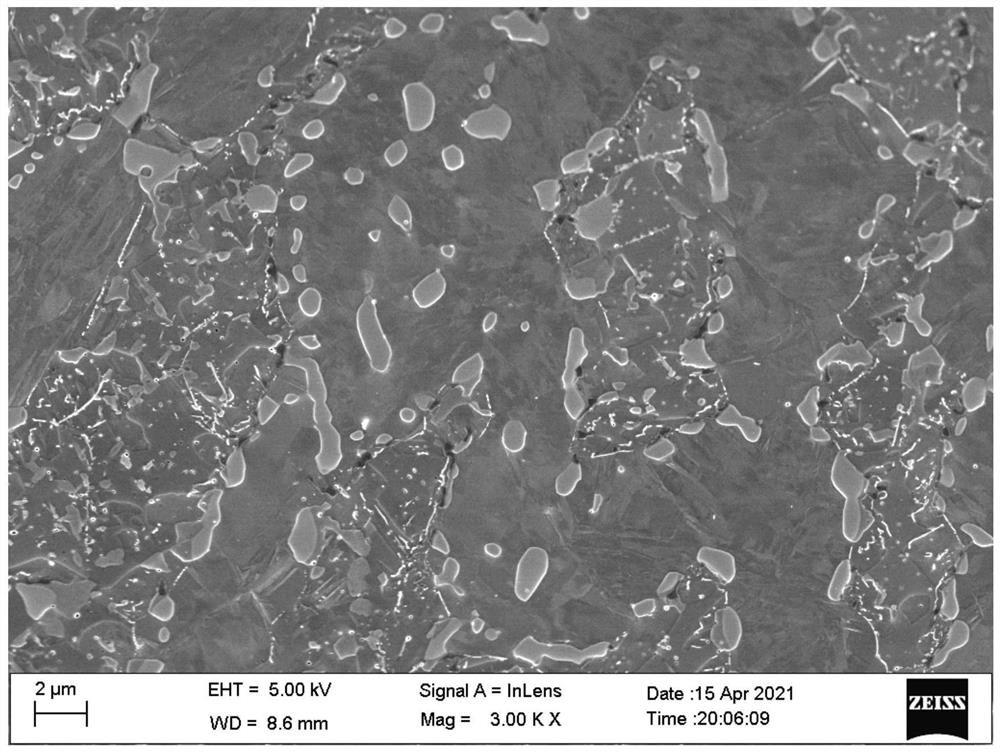A Heat Treatment Process for Improving the High Temperature Tensile Plasticity of Heat Resistant Alloys
A technology of heat-resistant alloy and tensile plasticity, which is applied in the field of heat treatment process to improve high-temperature tensile plasticity of heat-resistant alloy, which can solve the problems of low yield strength and low strength at high temperature, achieve good tensile plasticity, increase strength, and prevent cracking Effect
- Summary
- Abstract
- Description
- Claims
- Application Information
AI Technical Summary
Problems solved by technology
Method used
Image
Examples
Embodiment 1
[0037] Step 1: Take the deformed heat-resistant alloy whose composition is heat-resistant alloy 1 in Table 1, the precipitation temperature of the second phase at the grain boundary of the heat-resistant alloy and the complete austenitization A c3 The temperatures were measured by experimental instruments and were 1102°C and 700.6°C, respectively. Now heat the heat-resistant alloy to 1000°C at a heating rate of 15°C per min, keep it warm for 30 minutes, and complete the solution treatment, and then water-cool to room temperature. Sample, the microstructure of the sample after solid solution treatment is as follows figure 1 shown. From figure 1 It can be seen that after the treatment in step 1, massive discontinuous precipitates precipitate at the austenite and martensite grain boundaries of the heat-resistant alloy, and their average size does not exceed 4 μm.
[0038] Step 2: Heat the sample after solid solution treatment to 750°C at a rate of 10°C per min, keep it warm fo...
Embodiment 2
[0040] Step 1: Take the deformed heat-resistant alloy whose composition is heat-resistant alloy 2 in Table 1, the precipitation temperature of the second phase at the grain boundary of the heat-resistant alloy and the complete austenitization A c3 The temperatures were measured by experimental instruments and were 1108°C and 706.4°C, respectively. Now heat the heat-resistant alloy to 990°C at a heating rate of 15°C / min, hold it for 30 minutes, and complete the solution treatment, then water-cool to room temperature, and the temperature of the cooling medium used for water cooling is not higher than 30°C. After the treatment in step 1, blocky phases are discontinuously precipitated at the grain boundary between austenite and martensite, with an average size of no more than 4 μm.
[0041]Step 2: Heat the sample after solid solution treatment to 750°C at a heating rate of 10°C / min, hold it for 12 hours, complete the aging treatment, and then water-cool, the temperature of the coo...
Embodiment 3
[0051] Step 1: The deformed heat-resistant alloy includes the following components by weight percentage, C: 0.05%, Cr: 11.5%, Ni: 1.6%, Mn: 10%, Si: 0.3%, B: 0.007%, Mo: 1.5 %, W: 4%, Cu: 1.2%, Al: 1%, and the balance is Fe.
[0052] It is measured that the precipitation temperature of the second phase at the grain boundary of the alloy is 1106°C, and its complete austenitization A c3 The temperature was 705°C. Now heat the heat-resistant alloy to 998°C at a heating rate of 15°C / min, hold it for 30 minutes, and complete the solution treatment, then water-cool to room temperature, and the temperature of the cooling medium used for water cooling is not higher than 30°C. After solution treatment, massive phases are discontinuously precipitated at the grain boundary between austenite and martensite, and the average size does not exceed 4 μm.
[0053] Step 2: Heat the sample after solid solution treatment to 760°C at a heating rate of 10°C / min, keep it warm for 12 hours, complete...
PUM
| Property | Measurement | Unit |
|---|---|---|
| size | aaaaa | aaaaa |
| size | aaaaa | aaaaa |
| size | aaaaa | aaaaa |
Abstract
Description
Claims
Application Information
 Login to View More
Login to View More - R&D
- Intellectual Property
- Life Sciences
- Materials
- Tech Scout
- Unparalleled Data Quality
- Higher Quality Content
- 60% Fewer Hallucinations
Browse by: Latest US Patents, China's latest patents, Technical Efficacy Thesaurus, Application Domain, Technology Topic, Popular Technical Reports.
© 2025 PatSnap. All rights reserved.Legal|Privacy policy|Modern Slavery Act Transparency Statement|Sitemap|About US| Contact US: help@patsnap.com



